15 Exposed Basement Ceiling Lighting Ideas That Transform Your Space
The basement—often overlooked, sometimes underused—holds so much potential. But when the ceiling is exposed, lighting becomes more than just about visibility. It becomes a design opportunity. Exposed pipes, beams, and ducts create a raw, industrial charm. The right lighting can enhance that look and make the space feel cozy, functional, and even stylish. In this…
The basement—often overlooked, sometimes underused—holds so much potential. But when the ceiling is exposed, lighting becomes more than just about visibility. It becomes a design opportunity. Exposed pipes, beams, and ducts create a raw, industrial charm. The right lighting can enhance that look and make the space feel cozy, functional, and even stylish.
In this guide, we’ll walk through 15 exposed basement ceiling lighting ideas that don’t just brighten the space—they breathe life into it. Whether your basement is a rustic retreat, a sleek home gym, or a family hangout, these ideas are tailored to bring out the best in your ceiling without hiding it.
Let’s uncover how to make your unfinished ceiling shine—literally.
15 Beautiful Exposed Basement Ceiling Lighting Ideas
1. Track Lighting for Flexibility
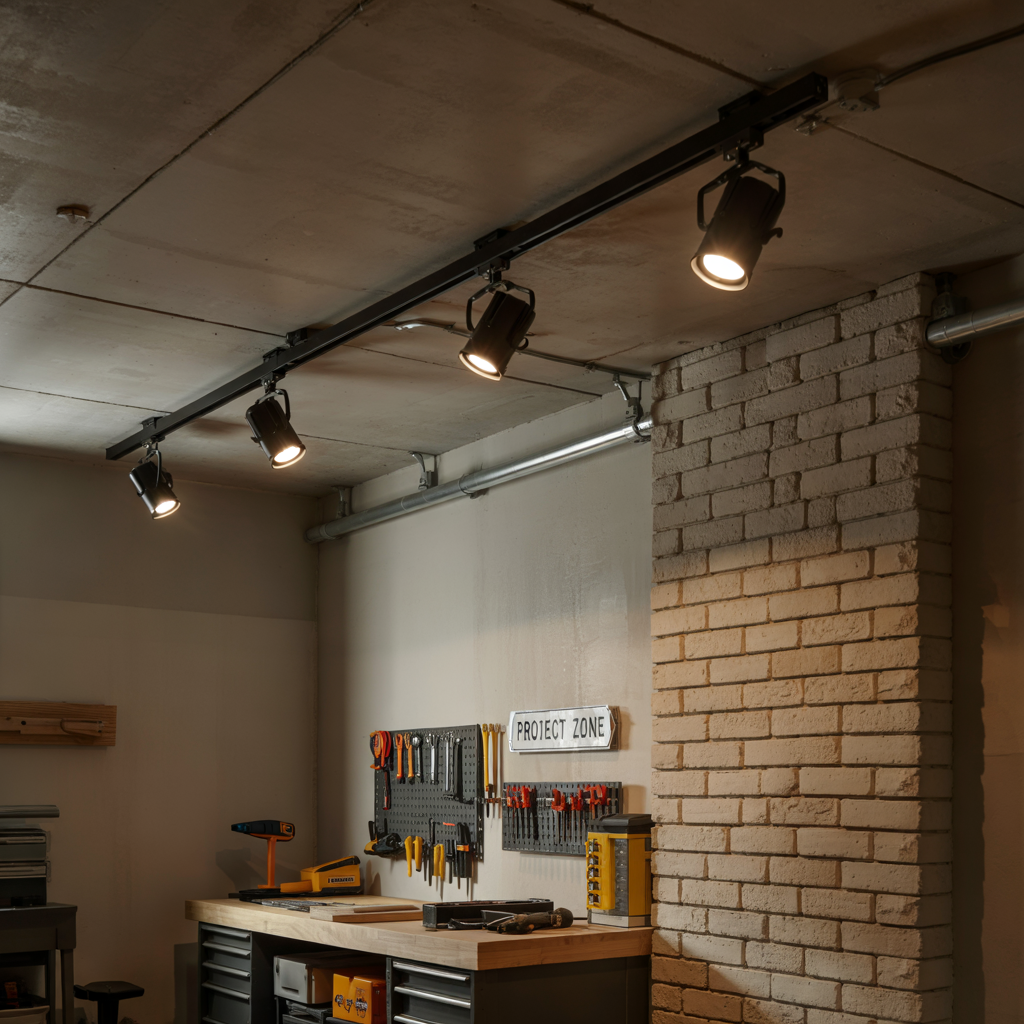
Imagine walking into your basement and being able to direct the light exactly where you need it. That’s what track lighting gives you. It’s one of the most versatile options for an exposed ceiling. Instead of hiding the pipes and joists, the fixtures blend right in, adding a modern, industrial vibe.
Track lighting works exceptionally well when you have multiple zones in the basement. Maybe a TV area in one corner, a reading nook in another, and a mini bar in between. Track lighting allows you to aim lights where they matter most. No need for multiple fixtures and outlets—just one powerful line doing it all.
- Benefits of track lighting:
- Easy to install along exposed joists or beams
- Adjustable heads for customizable lighting
- Sleek, modern aesthetic that complements industrial ceilings
- Great for spotlighting art, shelving, or workspaces
Read More: Can LED Lights Burn Out? A Comprehensive Guide
2. Pendant Lights Between the Joists
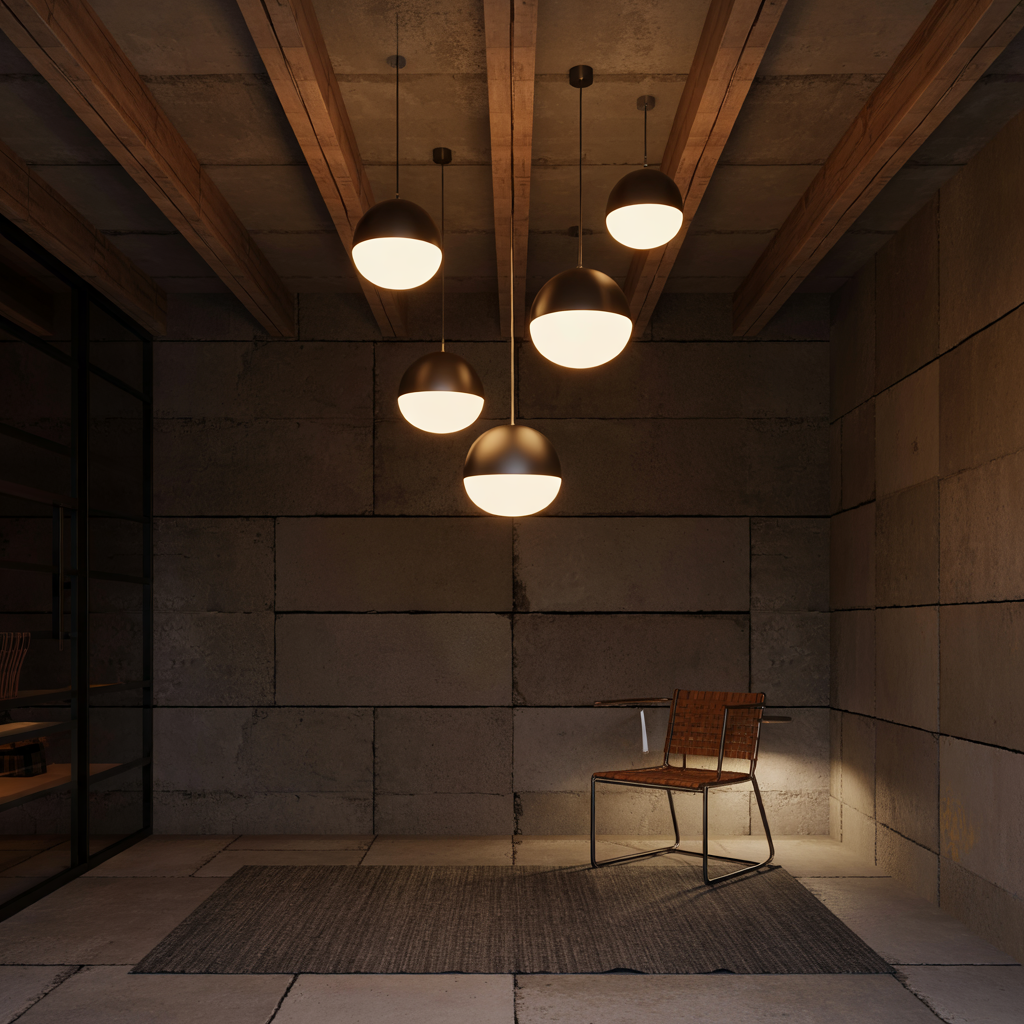
Pendant lights aren’t just for kitchens or dining rooms. They bring warmth and character into a basement with exposed ceilings. By hanging them between ceiling joists, you keep the space open while adding focused lighting that feels intentional and stylish.
Picture this: black wire pendant lights hanging just below copper pipes and wooden beams. The soft glow spreads downward, highlighting your basement couch or game table. It’s moody yet practical—a design statement that doesn’t feel forced.
Choose pendants in a finish that matches the rawness of the space—matte black, weathered copper, or brushed steel all work beautifully. Use Edison bulbs if you want that vintage-industrial charm.
Read More: Does LED Light Therapy Work? Does It Really Work?
3. LED Strip Lighting Along Beams
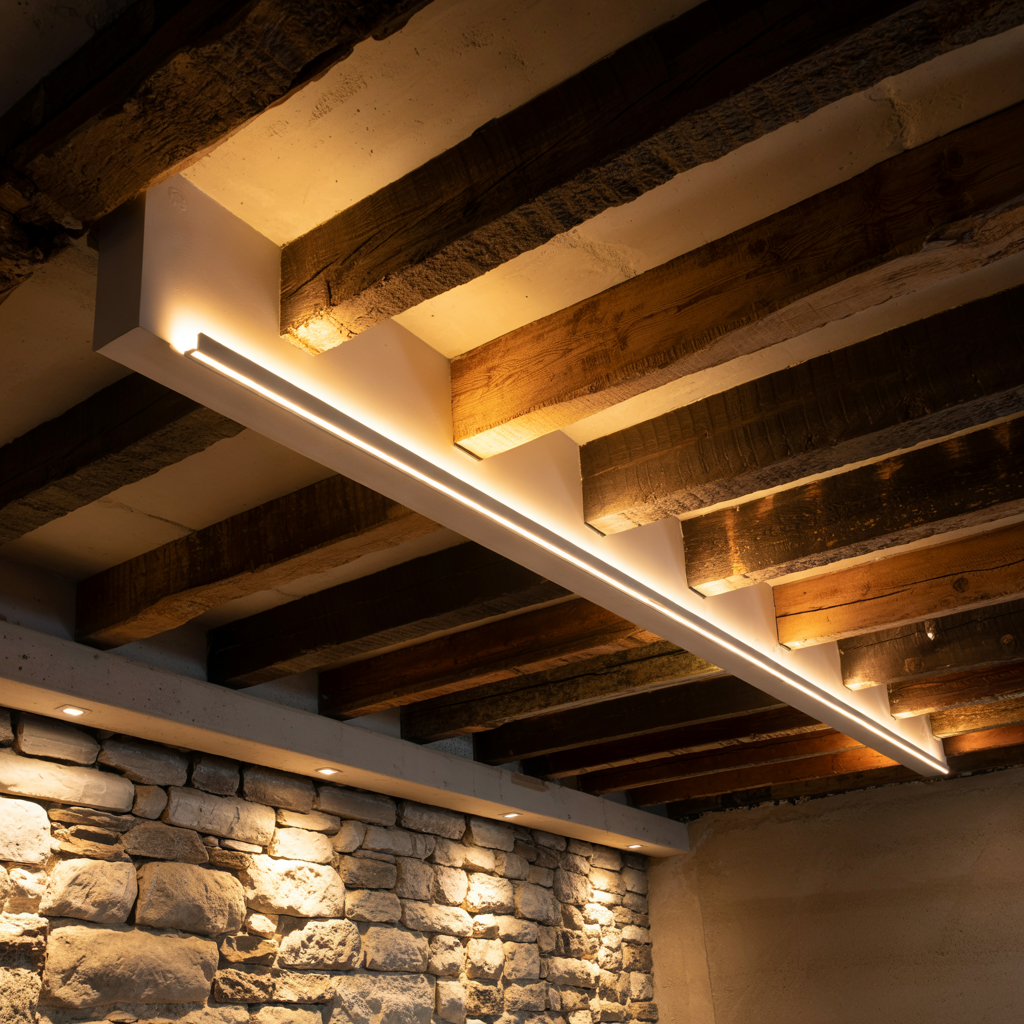
There’s something futuristic about LED strip lighting. When installed along the length of beams or pipes in your basement ceiling, it feels like the whole room is glowing from the inside out. This is a subtle, low-profile lighting idea that doesn’t require bulky fixtures.
You can tuck the strips along the edges of wooden beams or even run them behind ductwork. The result? A floating light effect that adds both ambiance and functionality. It’s especially effective if you’ve painted your ceiling black or charcoal gray.
- Why LED strips work in basements:
- Energy-efficient and long-lasting
- Easy to conceal along architectural lines
- Offers color customization with smart LED options
- Enhances depth and dimension in unfinished ceilings
Read More: How to Connect LED Strip Lights? Connecting LED Strip Lights
4. Recessed Can Lights in the Joist Bays
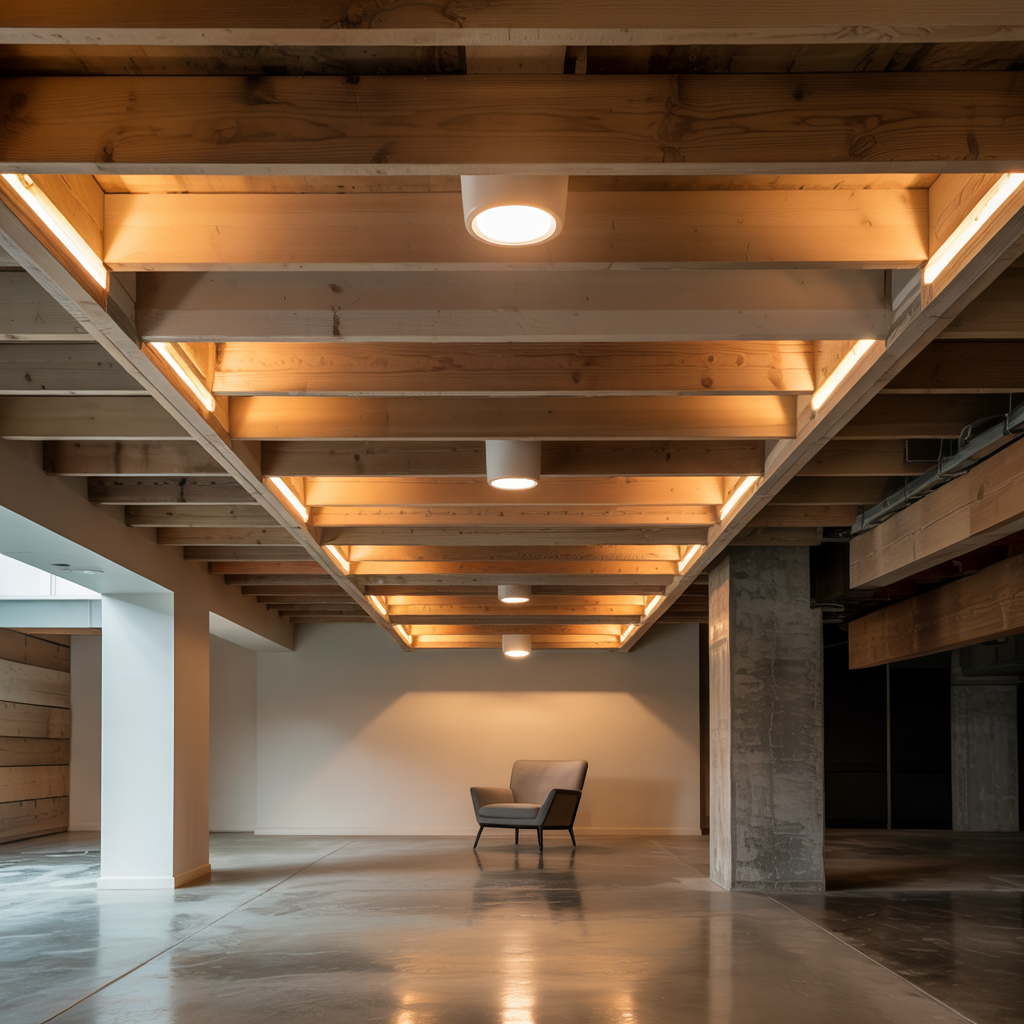
You might think recessed lighting only works in finished ceilings, but that’s not true. With a little creative installation, recessed can lights can be placed within the bays of your exposed joists, providing a clean, integrated lighting solution.
This approach is ideal if you’re going for a minimal look. The lights are practically invisible until they’re on, giving the room a sleek vibe. You can space them evenly across the ceiling, ensuring full coverage without clutter.
Just make sure to use shallow housings designed for non-insulated, exposed ceilings. It’s a bit more work upfront, but the result is stunning—clean light in a clean space.
5. Vintage Edison Bulbs on a Wire Grid
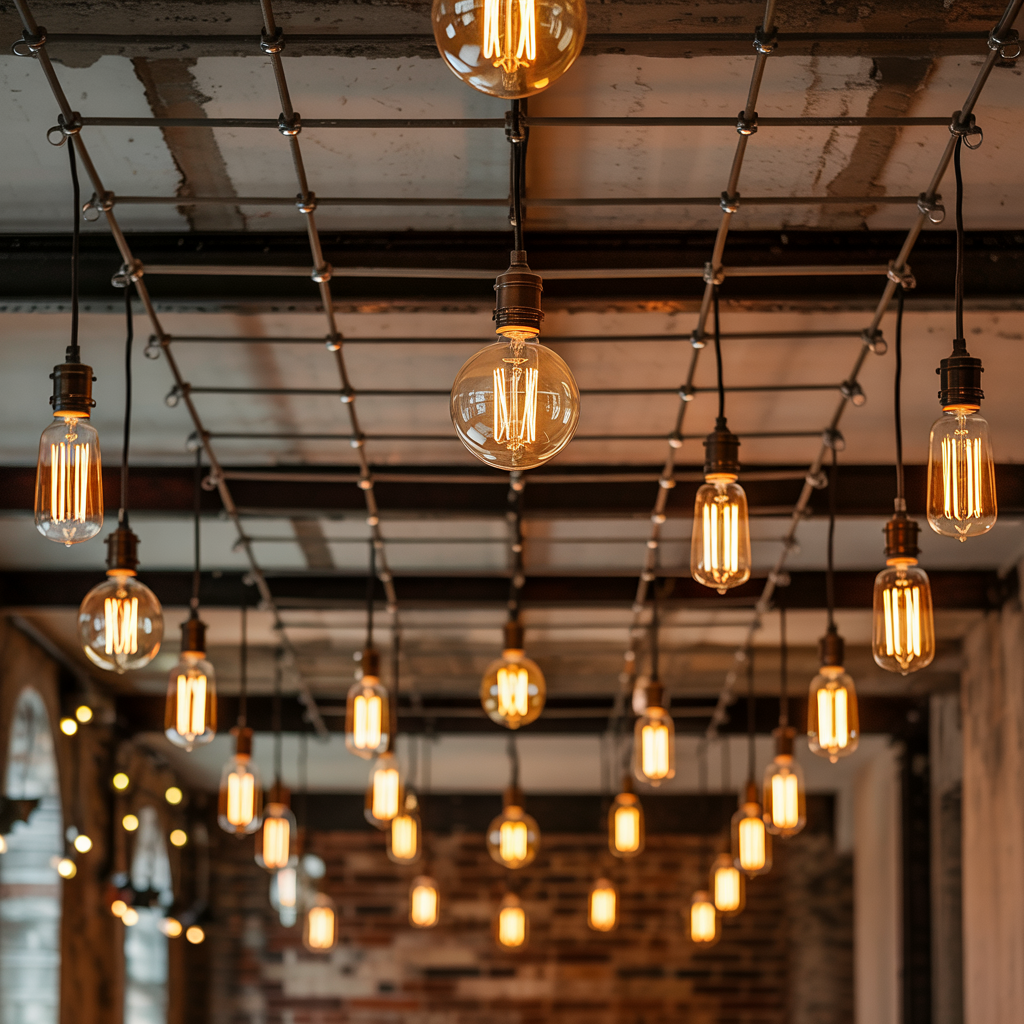
Nothing says rustic charm like a cluster of Edison bulbs. They don’t need fancy fixtures—just a wire grid or metal frame attached to your ceiling beams. It’s a design that embraces the rawness of the space rather than trying to cover it up.
When the bulbs glow, they cast a warm, golden light that softens the hard lines of wood and metal. It feels cozy, inviting, and a bit nostalgic—like you’ve stepped into a hidden speakeasy or artist’s loft.
- Why Edison bulbs work beautifully in basements:
- Vintage flair enhances exposed materials
- Affordable and easy to install
- Perfect for ambient lighting or dimmable setups
- Pairs well with metal, brick, and wood elements
6. Hanging Shop Lights for Industrial Charm
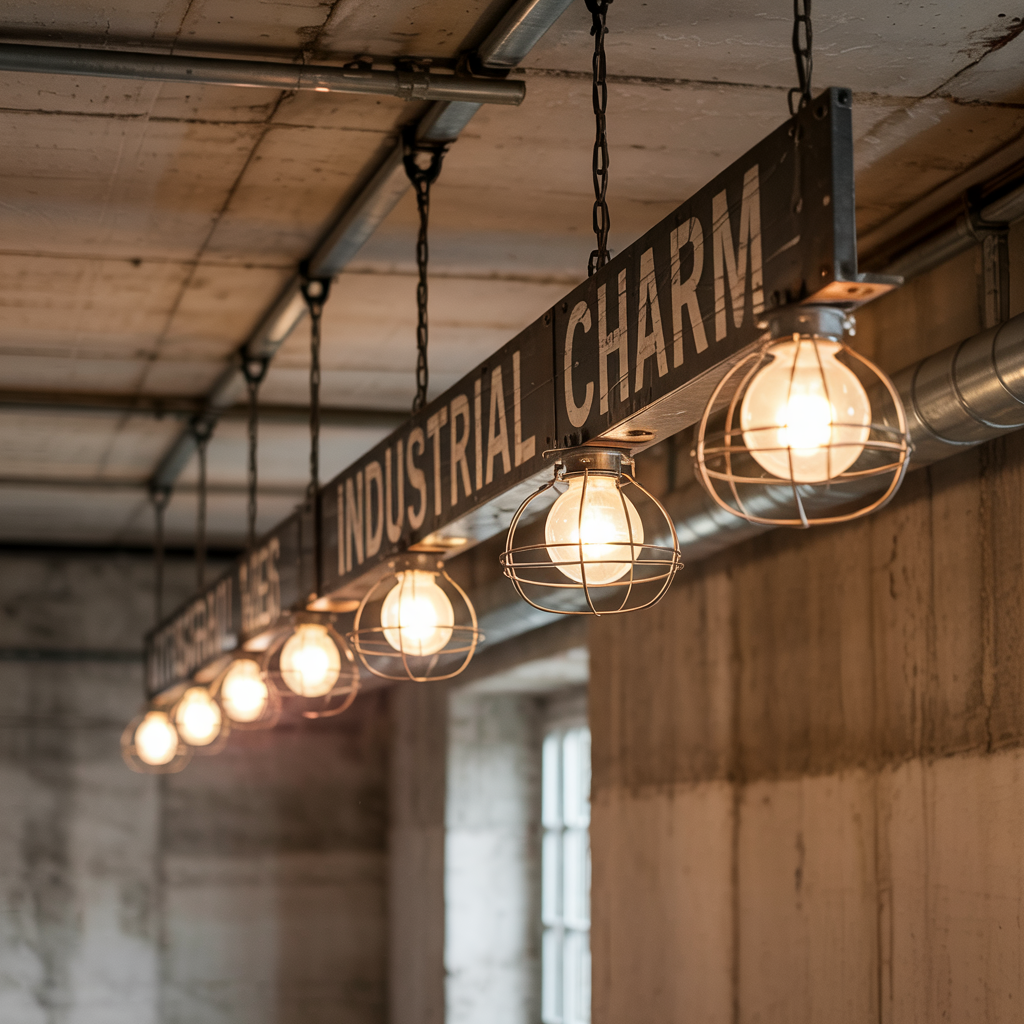
It’s not just about function—it’s about fashion too. Hanging shop lights used to be only for garages and workspaces, but now they’re turning heads in exposed basement designs. Suspended from chains or rods, they bring an unapologetically industrial look.
Use them above workbenches, ping pong tables, or laundry areas. These lights are bright, budget-friendly, and surprisingly stylish when matched with black cords and metal shades. Think utilitarian chic.
Choose warm LED bulbs to tone down the intensity. The shop light look isn’t about glare—it’s about making a bold statement with clean lines and practical design.
7. Wall Washers for Highlighting Brick or Concrete
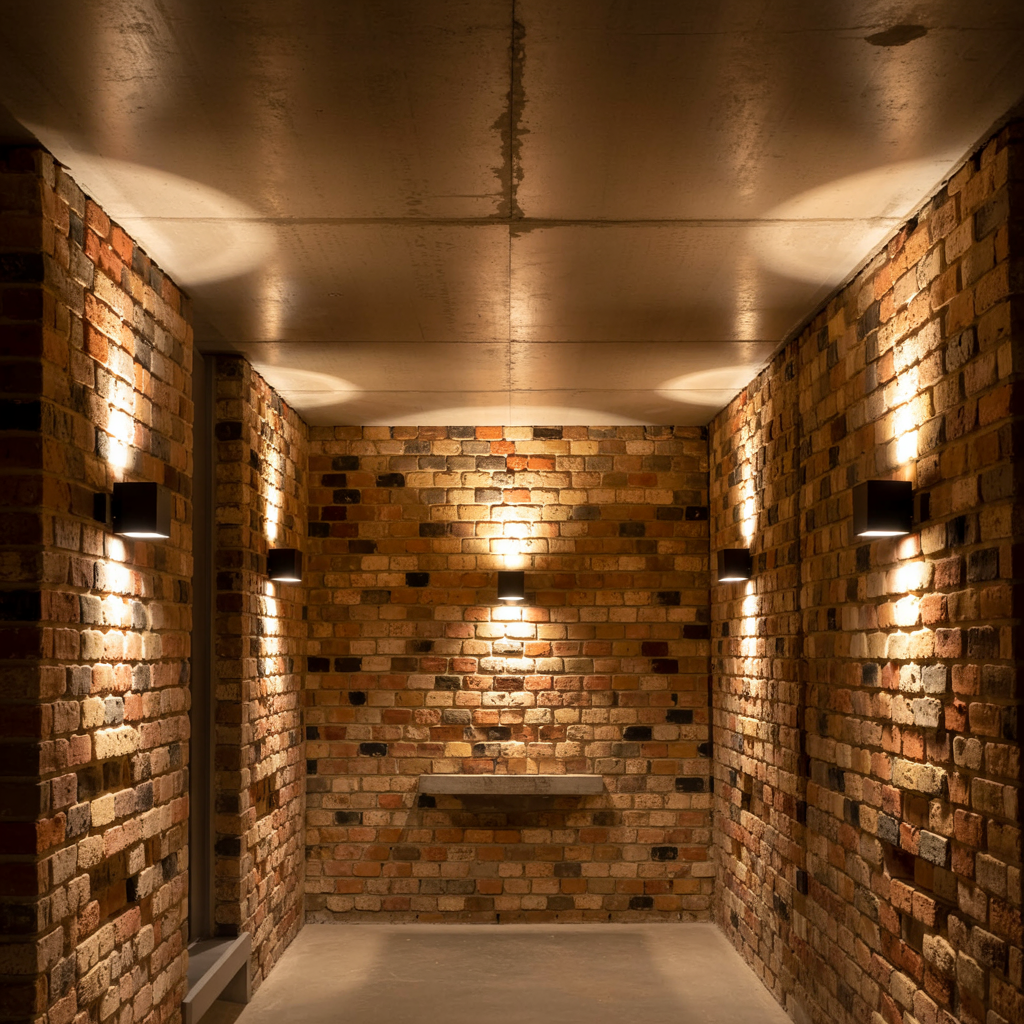
If your basement has exposed brick or concrete walls, don’t hide them—highlight them. Wall washer lighting is installed along the top edge of a wall and casts light downward, emphasizing texture and depth.
It’s especially effective when paired with exposed ceilings because it draws the eye downward while making the whole room feel warmer. Your raw basement starts to feel like a high-end loft.
- Ideal areas for wall washers:
- Behind a TV or entertainment center
- Along a hallway or stair wall
- Behind a sofa or reading nook
- On structural concrete or stone columns
8. Black Ceiling with White Fixtures for Contrast
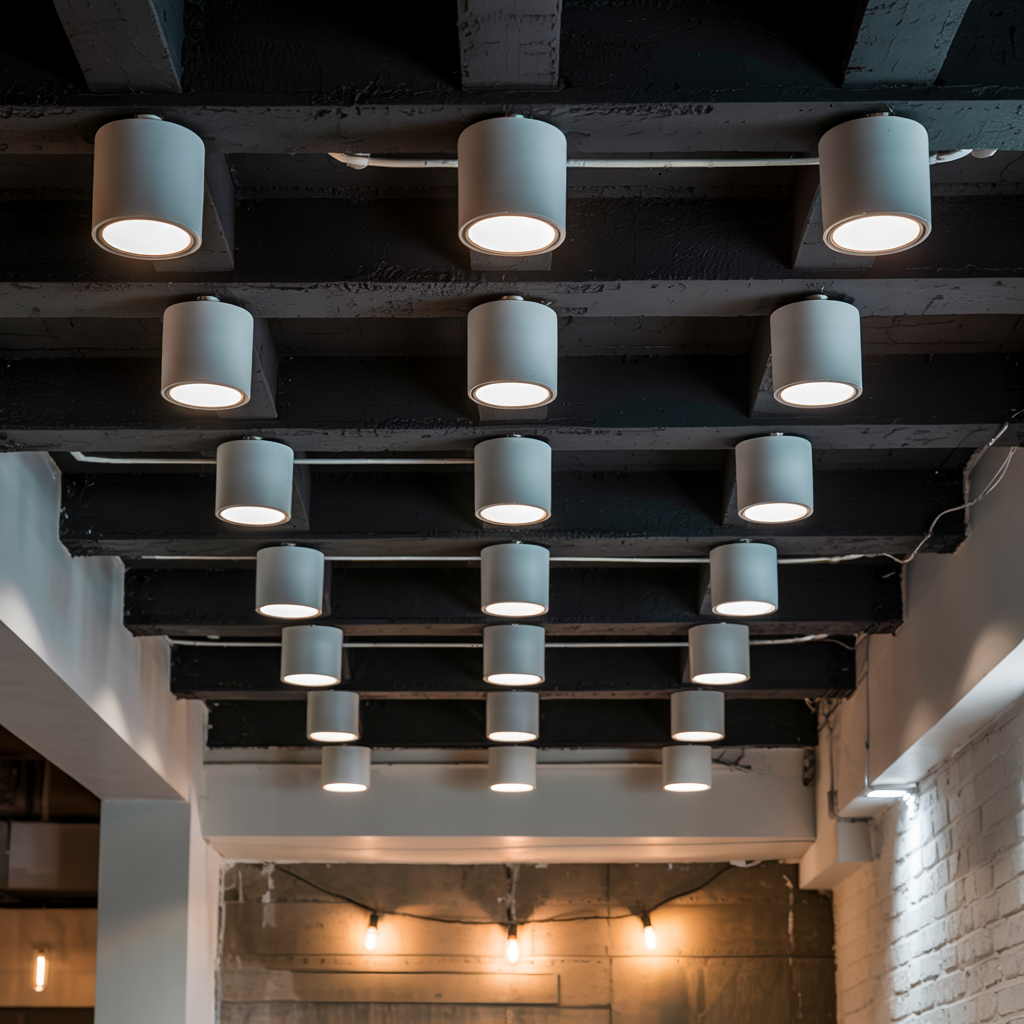
Sometimes contrast creates the biggest impact. Painting your exposed basement ceiling black and using white or brushed steel fixtures creates a dramatic visual tension that feels both modern and refined.
This idea works well in basements with good natural light or bright flooring. The dark ceiling hides ductwork and pipes, while the light fixtures pop against the black. It’s a clever way to work with what you have.
Use globe lights or track systems for the best effect. The key is in the visual layering—the black absorbs, the white reflects, and your basement becomes a space worth showing off.
9. Mason Jar Lights for a Cozy, Farmhouse Feel
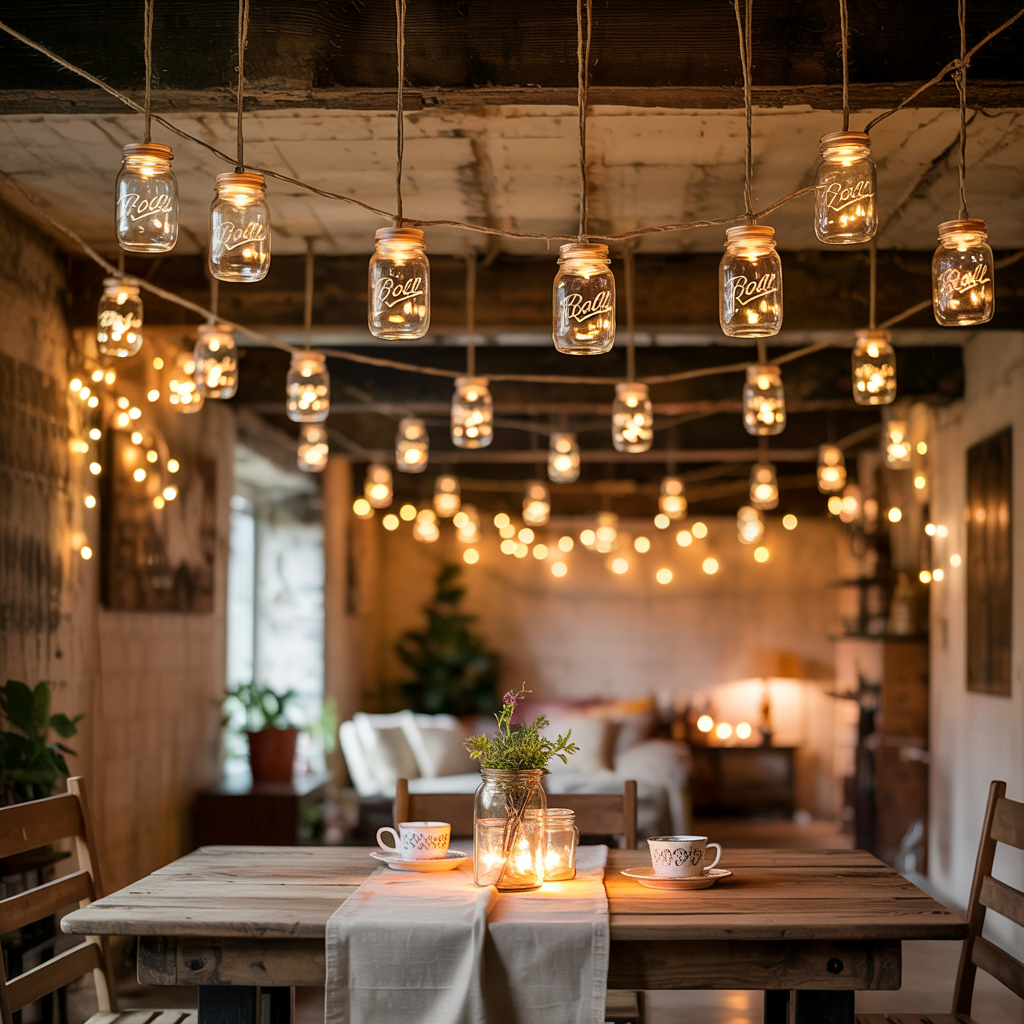
Bring a bit of the farmhouse indoors with mason jar lighting. It’s charming, simple, and totally DIY-friendly. String up jars with vintage-style bulbs inside and hang them from the ceiling using hooks or rods.
This setup softens the industrial edge of exposed ceilings and adds a handmade feel. It’s perfect for family rooms, game areas, or even bar spaces within the basement.
- Why mason jar lighting shines:
- Affordable and easy to customize
- Great for cozy, relaxed atmospheres
- Adds a personal, crafty touch
- Works well in clusters or rows
10. Bare Bulbs Suspended from Fabric Cords
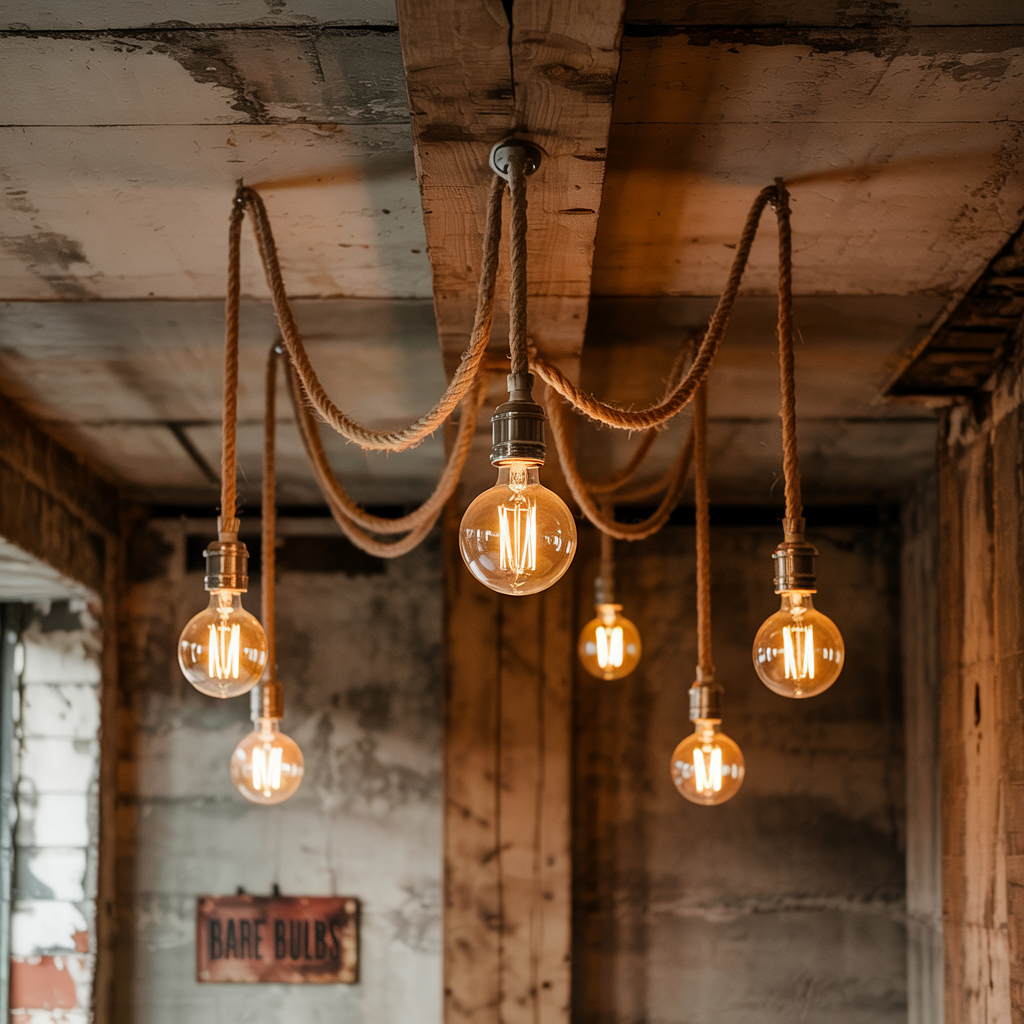
Minimalism can be incredibly elegant. Hanging bare bulbs from colored or fabric-wrapped cords creates a delicate, artsy look. Each cord can be a different length, giving the ceiling a playful rhythm that contrasts with the structural beams.
This idea is especially appealing in modern or bohemian-style basements. You don’t need covers or cages—just good bulbs and thoughtful placement.
Choose cords in bold colors for extra flair, or go all black for a cleaner, streamlined look. It’s budget-friendly, beautiful, and easy to install on your own.
11. Flush Mount Fixtures for a Streamlined Look
When height is an issue—or if you just prefer a sleek profile—flush mount lights are your friend. These fixtures attach directly to the joists or subfloor above, providing full lighting coverage without hanging down into the space.
They come in a range of styles, from industrial to modern to farmhouse. Whether you want brushed nickel, matte black, or wood-accented designs, flush mounts let you keep things simple and stylish.
- Best places to use flush mounts:
- Low-ceiling areas
- Laundry rooms or storage spaces
- Entryways from the garage or backyard
- Anywhere you want wide coverage without clutter
12. LED Panel Lights for Full Brightness
For those who want their basement to feel as bright as day, LED panel lights are the answer. Mounted between joists or on surface tracks, these ultra-thin panels cast even, shadow-free light across the room.
They’re ideal for home offices, gyms, or any area where good visibility is a must. You don’t have to sacrifice design either—modern panel lights come in sleek, understated frames that blend well with exposed ceilings.
Just make sure to choose dimmable options so you can adjust the mood as needed. Bright when you need it, soft when you don’t.
13. Fairy Lights Along the Beams
Sometimes the simplest touches make the biggest difference. Running strands of fairy lights along your exposed beams or pipes adds whimsy, romance, and just the right amount of glow. It’s not meant for task lighting—it’s for mood.
Fairy lights work beautifully in guest areas, reading nooks, or kids’ playrooms. You can choose warm white for a cozy feel or go with color-changing versions for fun effects.
- Tips for fairy lights:
- Wrap them loosely around beams or conduit
- Pair with sheer fabric for a dreamy vibe
- Use battery-operated or plug-in versions
- Hang in zigzags or straight lines
14. Industrial Cage Lights
Industrial cage lights are the perfect match for an exposed ceiling. The metal cages protect the bulb while adding a gritty, warehouse-like feel. Install them as pendants or flush mounts for different effects.
The key is to let the materials speak—wrought iron, galvanized steel, aged bronze. These fixtures work best with warm Edison-style bulbs and look especially good near brick walls or metal ductwork.
They strike that balance between rugged and refined, making your basement feel curated, not unfinished.
15. Motion-Activated Spotlights for Utility Areas
Let’s not forget the purely practical. In basement storage zones, laundry corners, or stairwells, motion-activated spotlights add safety and convenience. No fumbling for switches—just walk in, and the light follows.
These lights can be mounted on beams, walls, or even pipes. Most are battery-powered, so you don’t need wiring. Despite being utilitarian, they still blend into an exposed ceiling with a no-fuss look.
Use them sparingly, but smartly. They’ll save energy and give your basement that extra touch of tech-savvy style.
FAQs
What is the best lighting for an exposed basement ceiling?
The best lighting depends on your style and function needs. Track lighting and LED strips are great for flexibility, while pendant or cage lights add character. Mix and match for layered lighting.
How do you light a low exposed ceiling in a basement?
Flush mount lights and recessed can lighting are ideal. These keep the vertical space open while ensuring even illumination. Avoid long pendants or bulky fixtures.
Can I use regular light fixtures in an exposed basement ceiling?
Yes, but make sure they’re compatible with your wiring and securely mounted to joists or beams. Industrial and minimalist fixtures often work best with exposed designs.
How do I hide basement wires when lighting an exposed ceiling?
Use conduit covers, cable trays, or paint cords to match the ceiling color. You can also run wires along beams for a cleaner look or use wire clips to keep things tidy.
Should I paint an exposed basement ceiling before installing lighting?
Painting the ceiling black, white, or gray can help unify the look and hide imperfections. It also helps lighting stand out and adds to the aesthetic appeal.
Conclusion
Lighting an exposed basement ceiling isn’t about hiding imperfections—it’s about embracing them. From raw beams to visible pipes, every element becomes a design feature when paired with the right light. Whether you want cozy ambiance, industrial flair, or full-on brightness, there’s a lighting idea here to make your basement a favorite spot in your home.
So go ahead—let those joists show, and let your lighting do the talking.

